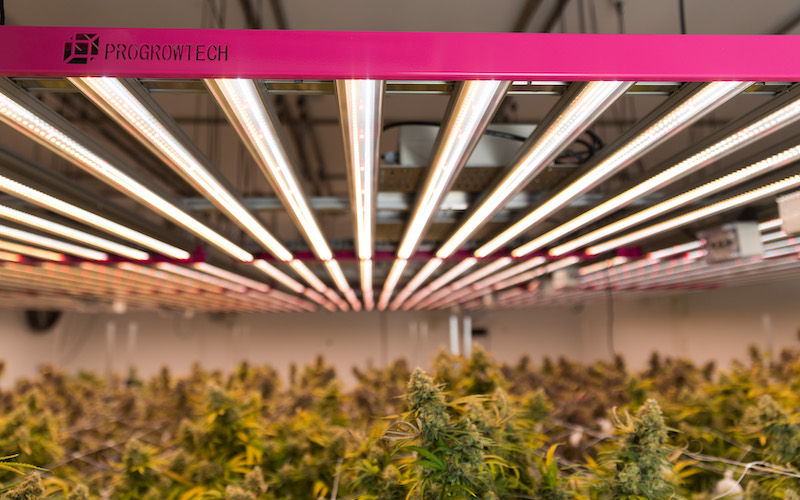There was a time in recent history when light emitting diodes (LEDs) were less effective for large cultivation facilities than their historically popular counterpart, High Pressure Sodium (HPS) systems. Fortunately, lighting science is evolving as the cannabis industry expands. Now the efficiency, sustainability, and improved yields associated with LEDs have been scientifically validated. A 2017 study presented at the Cannabinoid Conference in Cologne determined LED lights can produce crops with 26-36 percent higher THC content than HPS lighting alone.
What’s changed? Design improvements like greater light uniformity allow cultivators to position their lights much closer to the plants themselves. Closer proximity dramatically increases the amount of light penetrating the canopy, improving yields. ProGrowTech CEO Andrew Myers elaborated, “On the most basic level, light is plant food. All things being equal, more light equals more growth, assuming you can manage plant stress. Our [LED] lights deliver a more gentle, full-spectrum light source, eliminating most plant stress response and creating the potential for greater yields.”
Related: Innovative LED Grow Lights That Both Enhance and Protect Your Plants
Other engineering advancements are further improving the versatility and profitability of LED lighting solutions. Spectral tuning capability is fairly new to the scene, but its utility is based around research that shows plants react differently to different colors of light. The ability to control which light spectrums are hitting which plants at specific times can give cultivators more control over their harvest. Myers explained, “When a plant sees light that has a more blue hue, it interprets that as an indication that it is early in the spring, meaning the plant doesn’t need to out-compete its neighbors for sunlight and can focus on root and stem development. This results in shorter, more robust plants. The opposite is true with a warmer, or redder, quality of light. This type of light causes plants to stretch, so you can open up dense indicas and achieve more optimal inter-nodal spacing, eliminating mold risk in the process.”
Until recently, many growers believed the middle of the visible spectrum was not photosynthetically viable for their crops. The misinformed notion equated to designers trying to fit all of their light energy into the red and blue areas of the spectrum. Recent research indicates that full spectrum light sources are actually the most effective for growing plants. According to Myers, “Plants can tolerate much higher light intensities without developing stress if the light is spread out over the entire spectrum and not overly concentrated on any one color, and green and yellow light penetrate much deeper into plant canopies than red and blue light. New, full-spectrum LEDs give a full three feet of canopy penetration, further increasing yield and quality of harvests.”
If higher yields aren’t enough incentive to make the switch to LEDs, consider the energy savings. According to Energy.gov, LEDs use at least 50 percent less energy than traditional incandescent lighting. Aligning one’s brand with sustainable ideals while saving money is good for more than the planet, it’s good for the bottom line.
For more information about LED Lighting Solutions, visit ProGrowTech.com
Author
-

Patricia Miller is an executive editor at Innovative Properties Worldwide. She explores science, technology, and policy shaping the legal cannabis sector. Follow her work when you subscribe to Cannabis & Tech Today at cannatechtoday.com/subscribe/ or visit her website https://patriciamiller.squarespace.com/.






